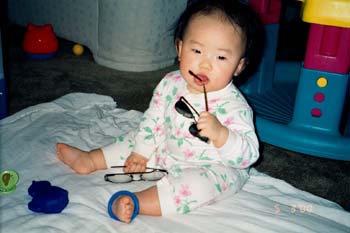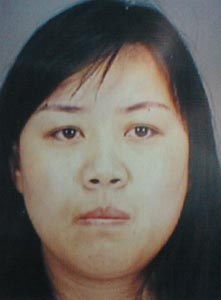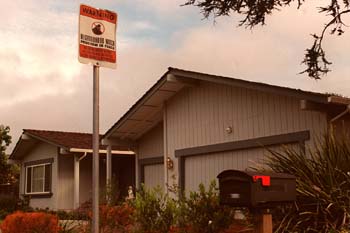![[Metroactive News&Issues]](/gifs/news468.gif)
[ San Jose | Metroactive Central | Archives ]
 Lost Child: Despite no history of child abuse and no witnesses to the crime, babysitter Katie Hsia now faces imprisonment and $5 million bail for the sudden death of Michelle Tang in Hsia's Saratoga home. On Shaky Ground A baby girl is dead and the Chinese-American community is rallying behind the woman in jail for her murder because the evidence for 'shaken baby syndrome' is shaky, at best By J. Douglas Allen-Taylor KATIE HONG HSIA WALKS into the basement courtroom of the Santa Clara County Courthouse with an anguished look on her face--a forest deer in a circle of armed hunters. The slim, slightly-built 31-year-old Chinese-American woman with straight black hair falling into her eyes glances frantically around the courtroom for a friendly face, but there are none for her here, only blank stares in return. All eyes in the courtroom are on her, it seems. Most likely she is seeking out her husband, Ed Hsia, but he has disappeared before her appearance, put off, perhaps, by either a reporter's questions or the unblinking eye of the Channel 11 news camera pointed in his direction. For Katie Hsia, the only support in the courtroom this July morning is her San Jose attorney, Sam Polverino, and her attorney cannot help her much in her first court appearance. She stands alone amid a row of rough, hard-faced men in green or orange county jail jumpsuits. Of them all, she is the only prisoner with her handcuffed arms shackled by chains padlocked to her sides. Of them all, Katie Hsia is the only one this day charged with "shaken baby death," the murder of her friend's nine-month-old daughter, Michelle Gingin Tang. When the judge affirms that Hsia's bail has been continued at $5 million, the courtroom of jaded onlookers gasps. Santa Clara District Attorney Randy Hey calls Tang's death "one of the worst attacks on a child ever seen" in this county and says that a not-yet-released autopsy will support the case. But observers in the Chinese-American and medical communities are not so sure. Some say the Katie Hsia/ Michelle Tang "shaken baby case" represents a rush to judgment against an innocent woman, without witnesses or physical evidence, charged only on the basis of an unproven medical theory. Second-Degree Murder ATTORNEYS FOR BOTH the prosecution and the defense agree on practically all the elements of the case. Michelle Tang's last day on earth began on a morning in late June when Michelle's mother, Xin "Cindy" Wang, dropped her off at the Hsia home on a quiet, cul-de-sac street in Saratoga. The only other person present at the Hsia house that morning was Hsia's 12-month-old daughter. Hsia and Wang, both natives of Beijing, China, were close friends, and Hsia often babysat while Wang attended classes at De Anza College. Hsia sold computer products online from home while taking care of her daughter. Hsia told Santa Clara County sheriff's deputies that Michelle was "really irritable" that day and that while she tried to feed her "the child fussed, refusing to eat." And then, two hours after arriving at the Hsia house, Michelle Tang suddenly stopped breathing. The deputies' reports recount the frantic following minutes in which Hsia attempted to administer CPR and then called 911. Michelle was rushed to Good Samaritan Hospital in Los Gatos, where she underwent emergency surgery to relieve pressure on her brain and was put on life support. Two days later, Michelle Tang died. The prosecution and defense theories of the death differ significantly. While she has not made a public statement since being arrested, Hsia's arrest warrant states that "suspect denied harming the baby and said no accidental injury occurred while the baby was in her care." However, following an autopsy, a child protection expert physician from Valley Medical Center concluded that Katie Hsia had shaken Michelle Tang to death. In a handwritten statement, Dr. Patrick Clyne wrote that "the nature of [Michelle's] injury is such that she would have immediate, profound neurological symptoms. ... She would not have appeared awake, alert and normal after the injury. ... [There are] no natural medical causes for these types of bleeding. Resuscitation efforts by rescue personnel could not have caused the injuries. ... [Michelle Tang] was the victim of an assaultive head injury and the assailant was the last adult with her immediately before the onset of her symptoms." Based upon Dr. Clyne's conclusions, Katie Hsia was arrested and charged with second degree murder. Her bail was set at $5 million because of the seriousness of the charges, and because prosecutors considered her, with family in China, a flight risk.
Close Friends MICHELLE'S FATHER, Allen Tang, does not know what to make of it. Asked if he and his wife think Katie Hsia is responsible for the death of their daughter, Tang says, "The only thing we can say is that we were really surprised. We don't know what she did. We just want to know the truth. At this time we don't want to say too much." However, Tang, a Chinese national who has worked in the Silicon Valley high-tech industry for five years, says he never saw anything in the past to indicate a problem with Hsia. In particular, he says he never saw her mistreat either Michelle or her own child. "She's a loving mother. That's why we trusted her," he says. Anguished, speaking slowly in a thick accent, Tang describes Hsia as a former co-worker (at a high-tech company he declined to identify) and as a close family friend who he considers to be partially responsible for the birth of Michelle Tang. "When [Katie] got pregnant she told my wife, 'Why don't you get pregnant, too?' My wife said, 'No, we're not prepared yet.'" Tang gives a small laugh. "But, surprisingly, we got a baby, too. So we always thought that [Katie Hsia] brought the baby for us. After my wife got pregnant and had the baby, our relationship got even closer. She was always doing things for us, like choosing the doctor, choosing the hospital, how to do this, how to do that. We just followed her. So when my wife asked her to take care of the baby for us, she was very happy to do that for us." Tang says that his wife did not want to talk about the situation. He has talked to the district attorney's office over the telephone but has not been interviewed. Tang and his wife are still struggling with accepting the death of their daughter, regardless of the cause. "We're Buddhists; we always ask ourselves, What did we do wrong? If the child died, it must be the parents that did something wrong. That doesn't mean we did something wrong in taking care of her. We just must have done something wrong in other places. It's all related. That's how we are as Buddhists. We pray. We really don't know how this could happen. We really don't believe our daughter is gone." Other friends and acquaintances of Katie Hsia expressed disbelief at the charges against her. "I can't imagine [Hsia] having any abusive or criminal part of her," says Mission College professor Marsha Chan. Five years ago, Chan taught Hsia in the college's English as a Second Language department and visited the Hsias in their home. Chan describes Hsia as a bright student, well-educated and responsible. "I can't even conjure up any case where she was even mean to anybody. It just doesn't fit." At Hsia's bail hearing a week after her initial court appearance, a string of witnesses describe her as "a very caring, gentle girl" who had "never raised her voice or been abusive to anyone." All described her as "good with children." "My babies got noisy sometime [around Hsia]," said Harry Ni, a networking engineer in the city attorney's office. "I never saw [her] upset with them." Neighbors of the Hsia's agree. "I never saw anything to cause alarm," says one, while another says, "The only strange thing about them was, they kept their Christmas lights up all year."
Hidden Injuries WITHOUT A witness against a well-respected defendant with no history of child abuse, what is the foundation of the case against Katie Hsia? It is based upon three injuries noted during Michelle's autopsy: subdural hematoma and subarachnoid hemorrhage, which involve bleeding in and around the brain, and retinal hemorrhaging, which involves bleeding inside the eyes. Since 1972, when it was first diagnosed, a majority of American physicians and forensic pathologists have concluded that the three symptoms combined can only occur when a baby has been violently shaken. When death is caused by such symptoms, a majority of doctors have concluded that the visible effects of such injuries would be immediate. In a letter called "a forensic pediatric response" following the Louise Woodward British au pair baby murder trial, Valley Medical Center's Dr. Clyne and a number of fellow pediatricians wrote: "Infants simply do not suffer massive head injury, show no significant symptoms for days, then suddenly collapse and die." Applying this theory to the Michelle Tang case, Clyne's conclusion was that because Michelle was alert and active when her mother left her at the Hsia house, the baby was assaulted by Katie Hsia. Calling such a theory "scientific garbage," Dr. John Plunkett says it is impossible to determine both time of injury and whether or not an incident is an assault based simply on the three "shaken baby" symptoms. A forensic pathologist and deputy coroner for several Minnesota counties, Plunkett has testified in "well over a hundred" infant assault cases. "What they are saying is contradicted by the knowledge of biomechanics that we have. You cannot cause either retinal hemorrhage or subdural hemorrhage by shaking a baby, no matter how hard you try. You can't generate enough force. It requires an impact. And an impact injury capable of causing this injury can come from a three-foot fall. And its symptoms are not necessarily immediate." Plunkett suggests three possible theories that investigators might look into to explain Michelle Tang's death: an old injury, a fall that might have taken place at the Hsia home outside of Hsia's presence, or a congenital condition in Michelle Tang's brain. "Nobody wants to see kids battered, all right? But it makes me sick because people are getting convicted and spending many, many years in prison based on this absolutely faulty science." A Palo Alto author of a book on shaken baby syndrome, Sue Luttner, agrees that prosecutors need to be cautious in relying solely on circumstantial medical evidence in so-called shaken baby deaths. A former programmer and a mother of two herself, Luttner is closely monitoring the Tang/Hsia case. Luttner cites five recent cases in which caretakers won either outright acquittal or were given reduced charges after initially being accused or convicted of murder in shaken baby deaths. Support Group SUPPORT IN THE Valley's Chinese immigrant community is growing for Katie Hsia. One week after her first appearance, some 20 friends and family members gather at the Santa Clara County Courthouse for Katie Hsia's reduced bail hearing. Ed Hsia folds his hands in his lap, closes his eyes, and mouths silent prayers in the courtroom in the minutes before the precedings. Katie Hsia says nothing during the hearing, listening through a Mandarin interpreter. Her husband refuses to talk to the press referring all questions to Sam Polverino, his wife's San Jose attorney. After the judge denies a reduction in Hsia's bail, her friends and family gather in a circle outside the courtroom to hear an explanation from Polverino. Afterwards, Ed Hsia translates the presentation into Mandarin. An articulate, medium-built man with a quietly commanding presence and the mental strength to mask his distress, it is clear that Ed Hsia would be a leader in this group even if it were not his wife on trial. Meanwhile, Katie Hsia has her wrists padlocked back to the shackles around her waist and is led by a sheriff's deputy back into the underworld of the Santa Clara County jail system, where she awaits her next day in court. [ San Jose | Metroactive Central | Archives ]
|
From the August 3-9, 2000 issue of Metro, Silicon Valley's Weekly Newspaper.
Copyright © 2000 Metro Publishing Inc. Metroactive is affiliated with the Boulevards Network.
For more information about the San Jose/Silicon Valley area, visit sanjose.com.
 Babysitter Katie Hsia.
Babysitter Katie Hsia.
